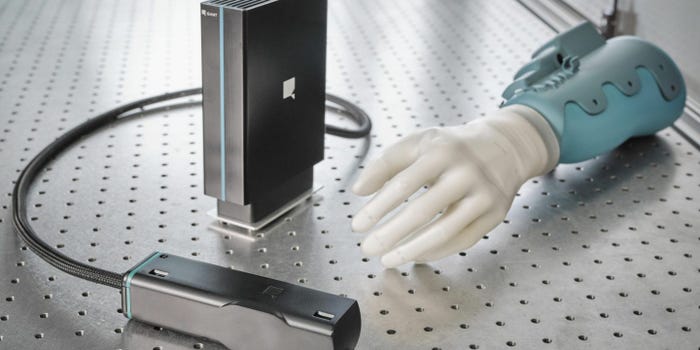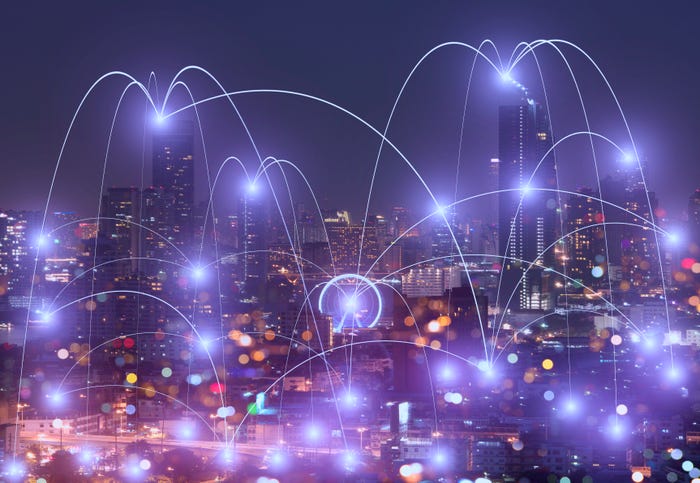Industry observers look into their crystal ball to foresee what is in store for the Internet of Things next year.
November 10, 2016

It’s still early days for the Internet of Things. As recently as 2014, 87 percent of consumers had never heard of the technology, according to Accenture. In 2016, and 19% of business and government professionals reported that they had never heard of the Internet of Things while 18% were only vaguely familiar with it, according to research from the Internet of Things Institute.
Although the technology is getting the most traction in the industrial space, the most promising use cases for the technology are just starting to come to light.
To get a sense of what to expect as we head into 2017, we spoke with Stanford lecturer and IoT author Timothy Chou, Ph.D.; Thulium.co CEO Tamara McCleary; industry observer and influencer Evan Kirstel; and Sandy Carter, CEO and founder of Silicon-Blitz.
1. IoT Will Influence the Omnichannel
IoT’s impact will be felt in the marketing world, says Sandy Carter, CEO and founder of Silicon-Blitz, who was named a 2016 Forbes Digital Influencer. “Omnichannel has been a hot topic owing to its focus on a single face to the customer,” Carter says. With IoT, presenting a single view of the data becomes easier whether you are a B2B or B2C company. The convergence of digital and physical worlds across multiple channels has created opportunities to measure and influence customer behavior beyond traditional purchasing cycles. Sensors, beacons, subscriptions, and digital capabilities have dramatically changed how businesses reach and manage customer relationships. This results in a transformation of marketing.”
CMOs need to understand how this new technology’s data can drive a competitiveness in the client experience, Carter says.
2. “Things” Grow Up
There is already a significant fork in the road between the consumer-oriented Internet of Things and the rest of the IoT, which spans everything from construction, transportation, agriculture, healthcare, oil and gas, energy, and water.
While industrial applications of the Internet of Things are in many ways more advanced than consumer-facing applications, the average amount of computing power in early industrial IoT applications is typically unimpressive. Stanford lecturer Timothy Chou suspects that the things in the IoT will get smarter in 2017. At present, the industry uses machines that are frankly fairly dumb. Chou says in the future we’ll see more intelligent technologies like quad-core microprocessors in Videojet industrial printers. It’s also possible that, in 2017, we’ll see early signs of “thing” computing software vs. personal computing software, Chou says.
As of 2016, many industrial machines are still not connected. Next year, there will be a steady transition towards more connectivity with LoRa—a low-power, long-range wireless protocol—at the low end or 60 GHz wireless technology at the high end.
Note: The IoT Institute has launched an online course titled “IoT Fundamentals & Examples of Business Transformation” based on Dr. Chou’s book, “Precision: Principles, Practices and Solutions for the Internet of Things.
3. Data Collection Migrates to the Cloud
Next year, data collection will move to the cloud, predicts Timothy Chou. And it probably won’t be based on SQL, he says. “Maybe we’ll see purpose-built collection services, and one of the big purposes will be to use AI algorithms to recognize not only someone’s speech but also how to optimize the operations of a machine,” he explains.
4. Recruiting Will Remain a Challenge for Organizations with IoT Initiatives
There is a huge difference between the Internet of Things and regular Internet. An average person now spends hours on the Internet each day. And scores of recent college grads covet working for tech companies ranging from Apple to Salesforce. But organizations launching digital transformation projects including smart cities and industrial facilities face a tougher time in recruiting talent.
Complicating matters is that it remains a challenge to find enough workers to secure the Internet of Things. 45 percent of IoT companies struggle to find security professionals, according to a TEKsystems survey. 30 percent report having difficulty finding digital marketers.
5. Companies Will Develop More Sensical IoT Products, But It Won’t Be Easy
In the early days of the Internet of Things, many vendors have attempted to woo consumers by adding connectivity to nearly every consumer device imaginable: couches, toothbrushes, tea kettles, coffeemakers, washing machines, and so on. Consumers mostly aren’t buying it.
Companies developing industrial IoT products have done a better job at understanding the needs of their clients, but many have continued to focus more on their technology than market demands.
More companies are now learning: Just because you can connect something to the Internet doesn’t mean that you should. In 2017, we will see a growing number of consumer-facing connected products that use connectivity to solve real problems. “There will be some unbelievable winners,” Evan Kirstel says.
Related: 15 Hard to Find IoT Skills
It won’t, however, be easy. “You don’t know what people want,” Kirstel adds. “I think this presidential election shows that.” Tech companies might talk about things like customer experience, but it is much easier to talk about market research than it is actually to understand what they truly want. “This is probably less true on the industrial side, but with things like the smart home, [IoT vendors] still are struggling to get inside the head of consumers,” Kirstel says. “With the IoT tech, you can’t just do focus groups. It becomes super important to truly understand people’s desires and motivations.”
They will also need to become more adept in explaining to consumers how connected products improve their lives, says Tamara McCleary. “That is where they get a sale.”
Consider, for instance, the smart refrigerator. When an ordinary consumer might hear of a Wi-Fi connected fridge, they might wonder: why would I need to have a fridge that is connected to the Internet? “How many people have heard about a connected refrigerator but they don’t know how it would make their life simpler?” McCleary asks. A connected fridge can, for instance, take snapshots of whatever is inside of it each time its doors are closed. “From a store, a consumer could look at their phone to see what is inside their refrigerator. Instead of trying to remember if I have green bell peppers, I can look.
6. IoT Market Will Continue to Expand Despite Security Risks
Conversations about IoT security are reminiscent of a parent lecturing a teenager about the dangers of smoking. Expect discussions about IoT security to be even more like that next year. Some IoT companies will be reckless when it comes to security—particularly in the consumer field. More companies, however, will begin to understand that security needs to be built into products.
In 2017, we are still likely to see more IoT-fueled botnets and other IoT security problems persist. There will be a steady stream of media coverage dedicated to the subject, and perhaps even a few big stories related to the topic that attract international attention. But the IoT industry will march on—especially in the enterprise and industrial markets.
“I think the Mirai botnet provided a course correction that had to happen. I believe it was a wakeup call that might prevent something bigger from happening other than having you not be able to access your Netflix,” McCleary says. “IoT technology is too fantastic to ignore it—especially for the enterprise and B2B markets. Anything that can improve the bottom line of a business is poised to succeed. For enterprise companies, IoT technology can enable companies to decrease their workforce, improve their supply chain, and make efficiency gains. The genie is already out of the bottle.”
Evan Kirstel agrees. “The ROI is just huge in the industrial and B2B markets. It will take time for IoT to proliferate in the home,” he sees. While there will be breakthrough hits in the consumer space, most of the IoT action will remain in the industrial market.
The outlook for the consumer IoT industry is less upbeat. “It is hard to imagine consumers standing up and demanding more secure IoT products. We had the biggest breach in history and what has changed. We have these DDoS attacks daily now. Where is the uproar?” asks Evan Kirstel. “It is telling that, earlier in 2016, an IoT home security SimpliSafe was hacked. But security seems low on the list of your average person’s concerns. There aren’t many people demanding action or legislation.”
There also isn’t an activist like Ralph Nader in the IoT field, who, decades ago helped create a movement that reformed the automotive industry, spurring it to make vehicles safer, Kirstel says.
While it is possible that IoT vendors try to transform security into a marketing angle, that pitch will likely not resonate with an average consumer for the foreseeable future. “Enterprise companies are demanding security whereas consumers don’t understand it yet,” McCleary says. “I do think that security will be important and people will get what they pay for. The danger is: if someone doesn’t understand IoT security, the rest of us could pay for it. In the past, if you decided you wanted to buy a cheap product from China and it broke, that was your loss. Now, if you decided to buy a cheap Internet-connected product from China and it is hacked, it is my problem.”
7. Winning IoT Products Will Have a Service Component
The IoT market is already flooded with products but few of them stand out. One that does is the Amazon Echo, says Evan Kirstel. The reason it does is because it ties into the Amazon backend to offer services—voice recognition, streaming music, the ability to hail an Uber, and so forth. “If it were a standalone device, it would just be a Bluetooth speaker,” Kirstel says. “Look at the iPhone, too. It would be a black slab without all of the services around it. The story is similar with the XBox and Playstation.”
This model is also gaining traction in the industrial realm. Companies like the German air pump maker Kaeser Kompressore have already shared their plans to sell “air as a service” rather than merely selling and renting compressors.
“You have to link products and services,” Kirstel says.
While there is a growing roster of IoT platforms, the service offerings they offer are often limited. “It is not enough to have a connected board,” Kirstel explains.
Stanford lecturer Timothy Chou agrees that new service-oriented business models are coming. In the past, most machine builders simply sold products. In the future, they could sell machines-as-a-service. “If modern machines are just a bunch of sensors and actuators with a big computer in the middle, then the evolution of the software industry will repeat itself,” he says.
8. Startups Will Gain Ground
In the past couple of decades, a handful of startups has made a fortune by developing technology to make consumers’ lives simpler. The same storyline could play out with the IoT.
Startups are better positioned to understand the pain points of the average person than a big company, says Tamara McCleary. “The big companies are often focused on how cool the technology is, but the technology itself doesn’t sell. The bigger the company, the slower they move. That is why startups have such an advantage,” she adds. Startups will leverage their agility and freshness of perspective to carve out a bigger share of the IoT market.
9. Standards Will Remain Messy
The Internet of Things industry has a Tower of Babel problem. There is nothing close to a shared language, and there are a plethora of competing standards. “If I was a developer and I wanted to connect an array of different kinds of connected devices, it would be easier if there was a standard way for them to communicate,” McCleary says. “But the standards are all over the place. And you won’t have a powerhouse like Google open and share open source standards. They want to retain control.”
The lack of IoT standards is similar to challenges that have stymied the healthcare industry for years. A recent survey revealed that only six percent of hospitals had a high level of interoperability, according to research from KLAS. “In the IoT space, it is similar. No one is responsible for the cost savings you would get by having standards,” McCleary says.
10. Diversity Will Remain a Challenge for the IoT Market
Despite all of the prominent programs to encourage women to pursue careers in technology, they still are underrepresented in the industry. Women earn less than 20 percent of computer science, engineering, and physics degrees in the United States, according to a University of Washington study.
“There has been a staggering decrease of women in the computer and information technology fields,” says McCleary. Data from the U.S. Department of Education supports that. In the early 1980s, more than 30 percent of computer and information science grads were women. In 1993, 28 percent of bachelor’s degrees in computer science went to women. By 2012, that figure had dropped to 18 percent.
At present, just 26% of computing occupations are held by women, and the number of female minorities in the field is in the single digits, according to research from the National Center for Women & Information Technology.
“It is hard to tell tech companies that they should employ more women when they don’t have a large enough talent pool to draw from and the pool is shrinking,” McCleary says. “Many women are interested in becoming involved in the Internet of Things market, but it is still a battle,” she adds. “I think there is a ton of desire for women to be more involved, but we are at the very beginning of this uphill battle, and we can’t give up, but I don’t see that we are on the brink of some giant transformation.”
According to Sandy Carter, CEO and founder of Silicon Blitz, there is a growing amount of evidence pointing to women’s leadership in the domain of IoT data. Women founded startups are disrupting industries like construction, manufacturing, retail, fashion, healthcare, and others, she says.
Another wrinkle related to diversity is the U.S. immigration system. “It is hard for people to cross borders. There is plenty of amazing talent in the world. There are great engineers in places like India and China, but it is hard to get them in the country,” Kirstel says.
11. Self-Driving Cars Begin to Shift Society
Some of the biggest tech and automotive companies in the world are aggressively working on launching fully autonomous vehicles. Tesla’s Elon Musk recently made waves recently by promising that, by the end of 2017, he’ll have a car ready that can drive from Los Angeles to New York without the need for a human driver.
While the potential safety benefits are attractive to cities, many city officials see self-driving cars as a threat. Many cities heavily rely on parking tickets, parking meters, and traffic violations. In 2015, New York City generated $1.9 billion in fees and fines. Imagine if all of that disappeared.
“A lot of cities don’t want traffic solved. There is a lot of money that comes from human failure behind a vehicle. If you eliminate all of that, it would be a threat,” McCleary says. “It would make more sense if cities tracked and charged owners of autonomous vehicles in a smart city. Your vehicle will be charged every mile for using their streets.”
The idea makes sense, agrees Evan Kirstel. “Self-driving cars could destroy old forms of revenue but create new ones,” he says.
The city of London could be a role model for other cities looking to tackle problems like traffic while also generating revenue. The city enforces that charge by using automatic number plate recognition technology. From 2003 to 2013, the scheme raised £2.6 billion in revenue, which enabled the city to make upgrades to their infrastructure and public transit network.
A similar transition could happen where government officials must rethink transportation to accommodate connected cars. “I think connected cars will help drive the Internet of Things forward,” says Evan Kirstel. “The first mobile phone deployment was car based. It was a logical place to put a phone. Similarly, the transportation industry is a logical place for IoT technology.”
About the Author(s)
You May Also Like


.png?width=700&auto=webp&quality=80&disable=upscale)
.png?width=300&auto=webp&quality=80&disable=upscale)


.png?width=300&auto=webp&quality=80&disable=upscale)